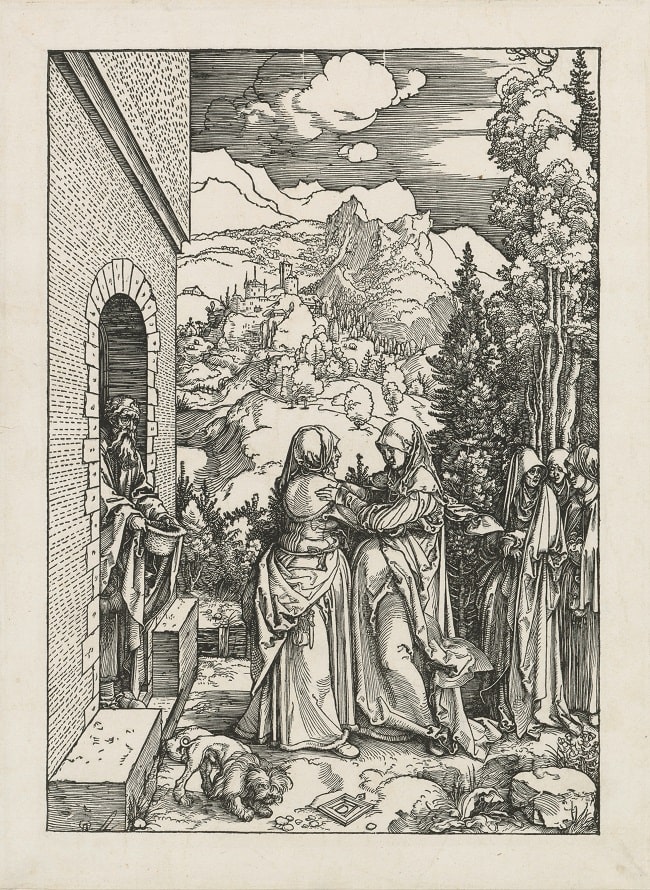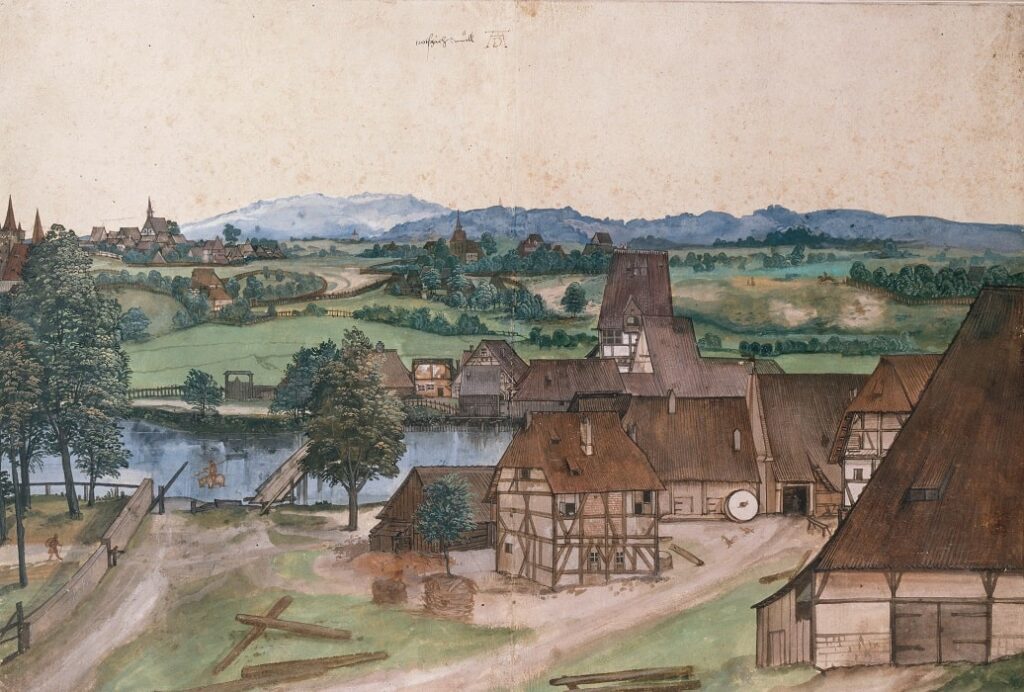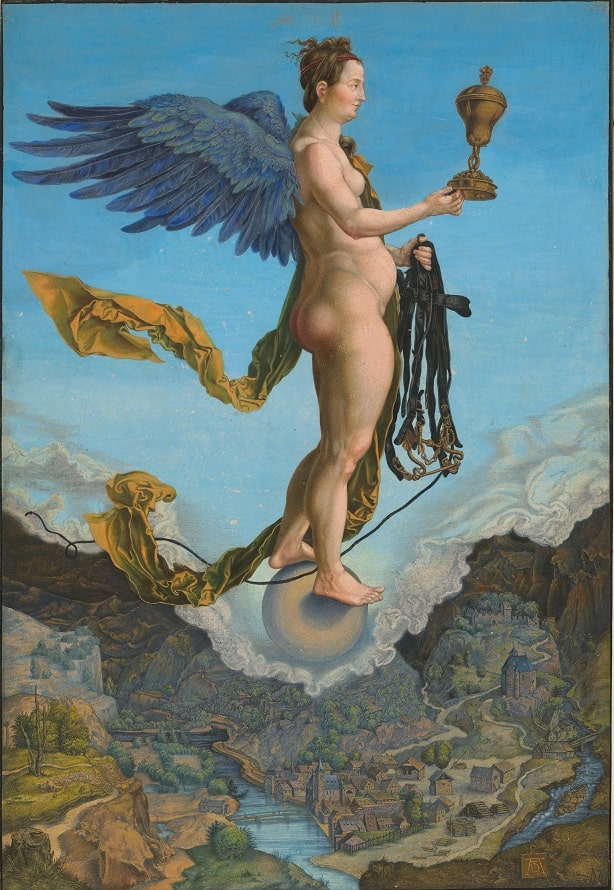From 12 May 2023, the Kupferstichkabinett in the Kulturforum will be showing the exhibition “Dürer for Berlin. A Search for Traces in the Museum of Prints and Drawings” of the artist Albrecht Dürer. The Berlin Kupferstichkabinett owns one of the world’s most important collections of Albrecht Dürer’s hand drawings and prints. With the help of around 130 masterpieces, the exhibition not only presents Dürer’s entire artistic oeuvre in an exemplary manner, but for the first time also makes the multi-faceted history of the collection itself visible. It leads from the beginnings of the Kupferstichkabinett (Museum of Prints and Drawings) in 1831 and the founding of the German Reich in 1871, through the Gründerzeit (Wilhelminian period) and the years of National Socialism, to the division of the holdings due to the war and their reunification in the Kulturforum in 1994.
Fig. above: Albrecht Dürer, Nemesis (Das große Glück), 1501, Kupferstich, deckend bemalt, Staatliche Museen zu Berlin, Kupferstichkabinett / Dietmar Katz
For generations, Albrecht Dürer (1471-1528) was and still is considered one of the most important, if not the most important artist in the German-speaking world. Even contemporary rulers used his art and personal fame for imperial appearances and representative works. Emperor Maximilian I (1459-1519), for example, commissioned Dürer with the famous giant woodcut of the Gate of Honour, still the most ambitious and largest woodcut ever made. Emperor Rudolph II (1552-1612) acquired large parts of Dürer’s artistic estate and brought it to Prague. Later it was brought to Vienna. And even after the end of the Holy Roman Empire, Dürer remained a central guiding figure for an entire generation of Romantic artists. Since 1828, the 300th anniversary of Albrecht Dürer’s death, he has been continuously honoured in commemorative events, not least in Berlin, where important artists such as Johann Gottfried Schadow, Karl Friedrich Schinkel or the young Adolph Menzel took part in the master honours.
And so Dürer’s role as a representative of an art of the nation was still very much present when the German Empire was founded in 1871 under Prussian leadership with Berlin as its capital. The newly founded imperial union of many individual states needed national identification figures. People were needed who could create, promote and legitimise a common identity across the borders of the individual constituent states. Dürer was particularly suited for this purpose. As the most important artist in the German-speaking world, he also fulfilled all integrative aspects of the new imperial idea from the Prussian point of view. Moreover, as the son of a goldsmith who had emigrated from Hungary, he was an artist with migration experience. It was precisely because of these complex interconnections that he eluded the clumsy chauvinistic appropriation by individual groups within the empire. His memory belonged to all.

So Dürer’s association with national interests was by no means new. But now his name was to be linked with the young capital of the German Empire – Berlin. Here, it was believed that a comprehensive and high-quality collection of Dürer drawings was already in their possession. It came mainly from the collection of the Prussian postmaster general Karl Ferdinand Friedrich von Nagler, which had been acquired in 1835 as an expanded founding collection for the Berlin Kupferstichkabinett. None other than Rudolf Count Stillfried-Alcantara, Master of Ceremonies of the Prussian King and German Emperor Wilhelm I, who was enthroned in January 1871, took this group of works as an opportunity to publish a magnificent publication on the Dürer drawings in the Berlin collection under Wilhelm’s patronage. With it, he referred to the coincidence of Dürer’s 400th birthday and the founding year of the Empire. But the publication caused a “Dürer dispute”, an early scholarly controversy in the founding days of the discipline of art history. It ended in the realisation that the Berlin Dürer collection was by no means up to international comparison at the time and that a remedy was urgently needed.
But it was not until the next generation around Richard Schöne (1840-1922), Wilhelm Bode (1845-1929) and above all the director of the Kupferstichkabinett, Friedrich Lippmann (1838-1903), that the loss of importance could be compensated. Lippmann was able to make spectacular acquisitions in the field of Dürer drawings and prints, aided by imperial support and the changing times. These works, acquired in the last quarter of the 19th century, catapulted the Kupferstichkabinett to the rank of a leading Dürer collection that it still holds today. The extremely revealing migrations and provenances of the prints between the metropolises of Vienna, Paris and Berlin are paradigmatic of Dürer collecting in this era. In addition, knowledge of Albrecht Dürer’s works was spread around the world through excellently illustrated publications. In cooperation with the Berlin institutes and picture publishers as well as the Reichsdruckerei, founded in 1879, a comprehensive and annotated facsimile edition of all Dürer drawings initiated by Friedrich Lippmann was the first illustrated catalogue of Dürer’s works to anchor research into Dürer’s work in Berlin.
By the time of his death in 1903, Friedrich Lippmann had made the Berlin Dürer Collection world famous. His successors in office continued Lippmann’s collection policy throughout the 1920s and 30s. Even during the National Socialist era, acquisitions from private collections long associated with the Kabinett continued. In addition, Dürer drawings and prints from other Berlin collections were transferred to the Kupferstichkabinett, but duplicates were also sold or exchanged.

The division of Berlin and the resulting split into the Kupferstichkabinette East and West resulted in a new situation. Both houses had only a part of the former collection at their disposal. However, since Dürer was still firmly anchored in the art historical canon as the national artist of the Germans, both museums made successful efforts to close particularly gaping inventory gaps. Thus, the Kupferstichkabinett on Museum Island integrated the rich Dürer collection of Beuth into its holdings and acquired an important key work in the form of the master engraving “Melencolia I”, while the Kupferstichkabinett in Berlin-Dahlem was able to acquire a complete “Ehrenpforte” (Gate of Honour), the counterpart of which was on Museum Island, in addition to several drawings in 1971 for Dürer’s 500th birthday.
The Dürer collection in the Museum of Prints and Drawings thus demonstrates the importance of Dürer’s art for Berlin and the formation of national cultural identities against the backdrop of changing socio-political conditions. Thus, even against the background of numerous Dürer exhibitions in recent years, this complex is a virtually born subject for the Berlin Kupferstichkabinett, which not only enables the didactic development of collection-historical contexts on site and in the catalogue, but also makes it possible to experience numerous masterpieces in the original. Thus, in addition to Dürer’s master engravings, famous woodcut series such as the “Apocalypse”, the “Life of the Virgin” or the “Rhinoceros” are shown in excellent condition. The focus, however, is on the graphic oeuvre, from which works such as “Dürer’s Mother”, the “Wire Drawing Mill” and preliminary studies for the “Feast of the Rosary” as well as numerous sheets from the famous “Sketchbook of the Dutch Journey” will be on display.
“Dürer for Berlin. A Search for Traces in the Museum of Prints and Drawings” is curated by Michael Roth, head curator of the Collection of German Art up to 1800 at the Museum of Prints and Drawings.
WHERE?
Kulturforum, Exhibition hall
Matthäikirchplatz
10785 Berlin
WHEN?
Opening: Thursday, 11 May 2023, 7 pm
Exhibition dates: Friday, 12 May – Sunday, 27 August 2023
Tue – Fri 10 am – 6 pm, Thu 10 am – 8 pm, Sat + Sun 10 am – 6 pm






